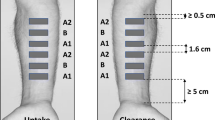Abstract
Objective:To investigate plasma and skin suction-blister-fluid pharmacokinetics of oral mizolastine in order to determine whether the drug concentration in the fluid of suction-induced skin blisters could better predict the antihistamine activity than the plasma concentration.
Setting:
Department of Internal Medicine, Université Paris 6.
Subjects:
Ten healthy male volunteers.
Methods:
The volunteers (mean age 26.8 years, mean weight 75.8 kg) received a single 10-mg oral dose of mizolastine at 1000 hours. The pharmacokinetic study included 11 plasma and 9 blister fluid samples and blister epidermal-roof specimens. Mizolastine was assayed by high-performance liquid chromatography (HPLC). Each volunteer also received nine intradermal injections of 5 μg histamine. Antihistamine activity was assessed as the post-treatment percentages of changes in the histamine-induced relative wheal and flare areas versus baseline.
Results:
Mizolastine mean Cmax (SD) and median tmax were, respectively, 380 ng ⋅ ml−1and 0.8 h in plasma, and 21.8 ng ⋅ ml−1 and 10 h in blister fluid. Mizolastine could not be quantified in the epidermis. The maximal histamine-induced relative flare inhibition was 72.5% and was attained at the median time of 3 h post-dosing and therefore was delayed by 2.2 h with respect to the plasma tmax. Mean relative wheal inhibition, although lower, showed the same time profile. A direct relationship could not be found between drug concentrations in blister fluid and antihistamine activity. Simulated concentrations in the peripheral compartment better explain the maximum inhibition effect on flare, observed 3 h post-dosing, with a flatter hysteresis loop obtained when plotting relative flare inhibition versus plasma or blister-fluid drug concentrations.
Conclusion:
The mizolastine concentrations in the skin suction-blister fluid were not predictive of the antihistamine activity.
Similar content being viewed by others
Author information
Authors and Affiliations
Additional information
Received: 23 November 1994/Accepted in revised form: 4 May 1995
Rights and permissions
About this article
Cite this article
Chosidow, O., Dubruc, C., Danjou, P. et al. Plasma and skin suction-blister-fluid pharmacokinetics and time course of the effects of oral mizolastine. E J Clin Pharmacol 50, 327–333 (1996). https://doi.org/10.1007/s002280050117
Issue Date:
DOI: https://doi.org/10.1007/s002280050117




